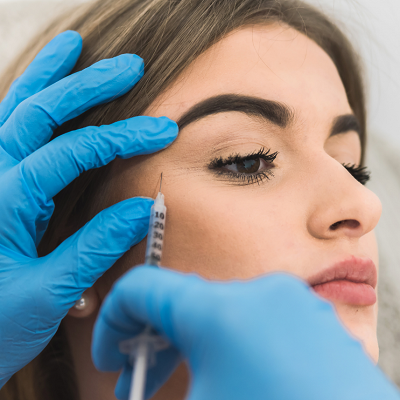
Dermal fillers are the best non-invasive cosmetic procedure for facial enhancement, smooth out wrinkles and restore the lost volume of the skin. They are instant and one of the most effective solutions to achieve flawless and youthful skin without any surgery however they are not permanent and wear off gradually. So many people ask What happens when dermal fillers wear off? What should we do? Should we restore them or let them fade? Read this blog to know what you should do when dermal fillers start fading and how to take care of them.
What are Dermal Fillers?
Dermal fillers are a type of non-invasive procedure in the form of an injection that is injected under the skin to smooth out the under eyes and wrinkle lines on the face to restore the youthfulness and glow of the skin. The procedure shows results right away and can last for months or years.
- Hyaluronic Acid (HA) Fillers: Juvederm, Restylane, and Belotero use hyaluronic acid, a naturally present compound in the body that attracts water and brings hydration.
- Calcium Hydroxylapatite (CaHA) Fillers: Some brands utilize this molecule to stimulate the production of collagen as well as give volume.
- Poly-L-Lactic Acid Fillers: Sculptra is one type of filler that encourages the natural production of collagen by the body over the course of time.
- Polymethylmethacrylate (PMMA) Fillers: Bellafill is a semi-permanent type of filler that gives long-term results by giving structural support to the skin.
How Long Do Dermal Fillers Last?
Each type of Dermal filler has a different life line which depends on its composition and the area being treated. Most fillers last between six months and two years before they slowly disintegrate and are absorbed by the body.
- Hyaluronic Acid dermal Fillers: 6-18 months
- Calcium Hydroxylapatite Fillers: 12-18 months
- Poly-L-Lactic Acid Fillers: Up to 2 years
- Polymethylmethacrylate Fillers: 5+ years
- Fat Transfer: Can be long-lasting but may require touch-ups
What happens when dermal fillers wear off?
1. Gradual Volume Loss
When fillers are absorbed, the skin slowly loses the volume added by them. This is a gradual and natural process, such that there’s no abrupt or dramatic change in your looks. The treated site will gradually regain its original state over time.
2. Reappearance of Wrinkles and Fine Lines
If you are given fillers to erase wrinkles or fine lines, these may begin to become visible again as the filler is absorbed. But with some fillers, they stimulate collagen growth, so even when they are gone, your skin will still have some improvement.
3. Skin May Feel Less Hydrated
Hyaluronic acid fillers, for example, draw moisture to keep the skin plump and hydrated. When they dissolve, the skin will be slightly drier or less supple than it was when the fillers were there.
4. Return to Natural Facial Structure
For those whose faces were filled to extend facial contours like filling out the lips, firming the jaw, or filling out the cheeks the filled area will eventually return to its original shape. If the fillers stimulate collagen formation, however, some degree of sustained improvement in skin elasticity and shape might persist.
5. No Permanent Stretching or Sagging
One of the most common myths about fillers is that they permanently stretch the skin and sag when they dissipate. True to character, however, good fillers will always break down, and the skin will for the most part return to what it originally looked like, with no apparent changes. If fillers were done excessively over a lifetime, however, there would be some minimal stretching, but this is a one-in-a-million chance and would depend on individual factors like elasticity and age.
How to Preserve Results and Reduce Changes
If you wish to preserve the results of your dermal fillers, these are some measures you can take:
- Get Touch-Up Treatments
- Treat Your Skin Well with a healthy skincare
- Use Collagen-Stimulating Fillers
- Have a Healthy Lifestyle
- Use Alternative Treatments like microneedling, laser treatments, etc.
Should You Refill or Let It Fade?
The decision to continue or stop using dermal fillers is entirely personal. Some people enjoy the temporary nature of fillers and choose to let them fade naturally, while others opt for regular touch-ups to maintain their desired look.
If you’re unsure, consult with a qualified aesthetic physician who can assess your facial structure and recommend the best approach for your needs.
Final Thoughts
As dermal fillers break down, your skin returns naturally to its former state without severe alteration. Some loss of volume and fine lines can reoccur, yet fillers may also provide residual benefits that can last in the form of enhanced collagen synthesis and skin hydration. If you treat your skin well and keep the idea of follow-up treatments in mind, you can prolong the effects of youth that dermal fillers give you or investigate other solutions best for your looks. Book your consultation with us and learn about dermal fillers, how they are done, their advantages and disadvantages, and What happens when dermal fillers wear off. And how to preserve them.






